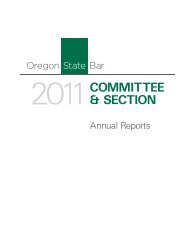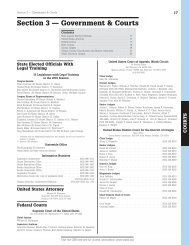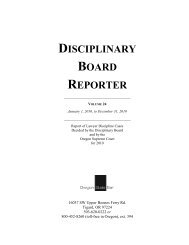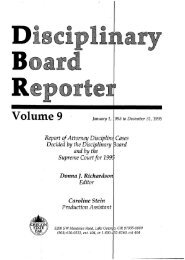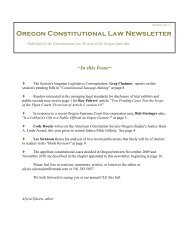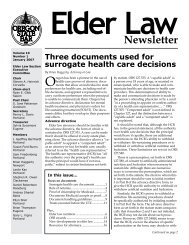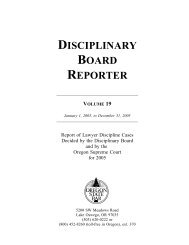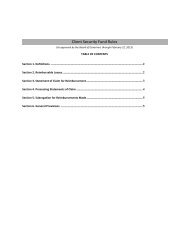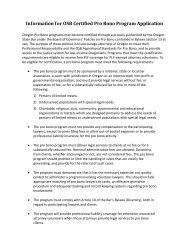February 22, 2013 - Oregon State Bar
February 22, 2013 - Oregon State Bar
February 22, 2013 - Oregon State Bar
You also want an ePaper? Increase the reach of your titles
YUMPU automatically turns print PDFs into web optimized ePapers that Google loves.
<strong>2013</strong> PLF BUDGET, AND <strong>2013</strong> PRIMARY ASSESSMENT PAGE 4<br />
OCTOBER 6, 2012<br />
assessment and 7,104 full-pay attorneys. Primary Program revenue also includes our forecast for<br />
SUA collecrions of $185,000 for <strong>2013</strong> and $196,000 for 2012. The <strong>2013</strong> budget assumes that there<br />
is no major change in the current SUA policies.<br />
Inveshnent returns were better than expected for the first six months of 2012. In doing the 2012<br />
projections and <strong>2013</strong> budget, we used the rates of return for the different asset categories recently<br />
recommended by R. V. Kuhns &Associates, Ina These rates are lower than those used during the<br />
2012 budget preparations. While the percentages chosen are significantly lower than historical rates<br />
of return achieved over long periods, they reflect the current reduced expectations of our investment<br />
consultants. Our calculation of inveshnent return projections for the remainder of 2012 and for<br />
<strong>2013</strong> began with the June 30, 2012 market value of all current investments. Investment revenue was<br />
calculated from July forwazd using 2.5 percent for the short-term cash flow bond fund, 4.25 percent<br />
for intermediate bonds, 7.9 percent for domestic equities, 8.65 percent for foreign equities, 7.00<br />
percent for hedge fund of funds, 7 percent for real estate, and 6.75 percent for absolute return. The<br />
overall combined expected rate of return for <strong>2013</strong> is about 6.61 percent. (The overall rate combined<br />
rate of return used in prepared the 2012 budget was 7.21 percent.)<br />
Primary Program Claims Expense<br />
By far, the largest cost category for the PLF is claim costs for indemnity or defense. Since claims<br />
often don't resolve quickly, these costs are paid over several years after the claim is first made.<br />
The calculation of claim costs is the largest factor in determining Primary Program profit or loss.<br />
For any given year, claim expense includes two factors — (1) the cost of new claims and (2) any<br />
additional upward (or downwazd) adjushnents to the estimate of costs for claims pending at the<br />
beginning of the year. Factor 1 (new claims) is much larger and much more important than factor 2.<br />
However, problems would develop if the effects of factor 2 were never considered, particularly if<br />
there were consistent patterns of adjustments. The "indicated average claim cosy' in the actuarial<br />
report calculates an amount for factor 1. The report also discusses the possibility of adding a margin<br />
to the indicated costs. Adding a margin could cover additional claims costs from adverse<br />
development of pending claims (factor 2) or other possible negative economic events such as poor<br />
investment returns. We have included mazgins in the past several years to good effect.<br />
The PLF experienced a significant increase in the frequency of new claims during 2008 and 2009.<br />
The frequency level declined during 2010 (13.6 percent) and 2011 (13.2 percent). Claims frequency<br />
for the first six months of 2012 was 13.6 percent, which is close to budget expectations. Claim<br />
frequency for the second half of 2012 will be distorted by a very large number of claims made<br />
against one lawyer. To date, 99 claims have been made against a single lawyer. The most these<br />
claims will cost of is one coverage limit. Accordingly, it is appropriate to make an adjustment to the<br />
projected claim frequency. If the 99 claims were considered to be 15 (about one coverage limit), the<br />
current projected claim count would be 935 which is less than 13.5 percent frequency. We feel that<br />
the actuaries will agree with the need for an adjustment and will modify their calculation of the<br />
December 31, 2012 in a similar manner. The 2012 projections of claim costs assume 935 claims at<br />
$20,000 per claim.




